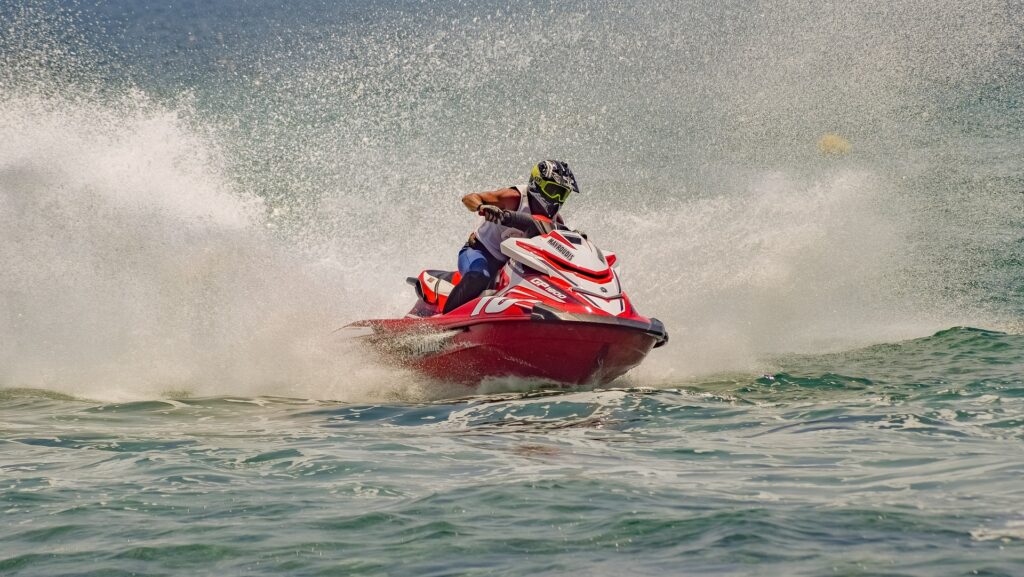When indulging in watersports activities such as jet skiing, kayaking, and paddleboarding, safety should always be a top priority. Whether you’re renting equipment or utilizing private cabanas, understanding and adhering to safety guidelines can ensure a positive experience on the water. Here are important safety measures to follow for each of the services you offer:
Jet Ski Safety Guidelines
Renting a jet ski can provide an exhilarating experience, but it’s crucial to prioritize safety to prevent accidents and injuries. Follow these guidelines for a safe jet skiing experience:
- Wear a Personal Flotation Device (PFD): Before embarking on a jet ski, make sure all riders wear properly fitting PFDs. This is a crucial safety measure that can save lives in case of an accident.
- Follow Operating Instructions: Familiarize yourself with the operation of the jet ski before heading out on the water. Understand how to start and stop the engine, control speed, and execute maneuvers safely.
- Maintain Safe Speeds: Obey speed limits and operate the jet ski at a safe speed, especially in crowded or congested areas. Avoid reckless behavior, such as sharp turns or sudden accelerations, that could lead to accidents.
- Keep a Safe Distance: Maintain a safe distance from other watercraft, swimmers, and obstacles such as buoys or docks. Be aware of your surroundings and adjust your course to avoid collisions.
- Use the Kill Switch: Attach the kill switch lanyard to your wrist or life jacket. In the event of a fall, the kill switch will automatically shut off the jet ski’s engine, preventing it from continuing to operate unattended.
- Check Weather Conditions: Before renting a jet ski, check the weather forecast for any signs of inclement weather. Avoid jet skiing in high winds, storms, or rough seas, as these conditions can increase the risk of accidents.
- Avoid Alcohol and Drugs: Never operate a jet ski under the influence of alcohol or drugs. Impaired judgment and coordination significantly increase the likelihood of accidents and endanger both the rider and others on the water.
- Take a Safety Course: Consider taking a jet ski safety course to learn essential skills and best practices for safe operation. Proper training can enhance your confidence and competence on the water.

Kayak Safety Guidelines
Kayaking is a peaceful and scenic watersport that requires careful attention to safety. Whether you’re renting a kayak or using your own, follow these guidelines for a safe kayaking experience:
- Wear a life jacket: Always wear a well-fitting life jacket while kayaking, even if you’re a strong swimmer. life jackets provide essential buoyancy and can save lives in case of capsizing or accidents.
- Inspect Equipment: Before launching your kayak, inspect it for any signs of damage or wear. Ensure that your paddle is in good condition and that all attachments are secure.
- Choose Appropriate Waterways: Select calm and sheltered waters for kayaking, especially if you’re a beginner. Avoid areas with strong currents, choppy seas, or heavy boat traffic.
- Practice Safe Launching and Landing: When entering and exiting the kayak, do so from a stable platform such as a dock or shoreline. Take your time to avoid tipping over or getting injured.
- Stay Visible: Attach a brightly colored flag or reflective tape to your kayak to increase visibility to other watercraft. This is especially important in areas with high boat traffic or low visibility conditions.
- Communicate Intentions: Use hand signals and verbal communication to indicate your intentions to other kayakers, boaters, or paddlers. Be courteous and respectful of others sharing the waterway.
- Stay Hydrated and Protected: Bring plenty of water and sunscreen to stay hydrated and protected from the sun’s harmful rays. Wear appropriate clothing to protect yourself from sunburn and overheating.
- Be Mindful of Wildlife: Respect wildlife and their habitats while kayaking. Keep a safe distance from animals such as seals, birds, and marine mammals, and avoid disturbing nesting or breeding areas.
Cabana and Paddleboard Safety Guidelines
Renting a private cabana or paddleboard can provide a relaxing and enjoyable experience on the water. Follow these guidelines for a safe and enjoyable time:
- Select a Stable Paddleboard: Choose a paddleboard that matches your skill level and provides stability on the water. Beginners may prefer wider, more stable boards, while experienced paddlers may opt for narrower, more manoeuvrable designs.
- Use Safety Equipment: Always wear a leash while paddleboarding to prevent the board from drifting away if you fall off. Additionally, consider wearing a PFD, especially if you’re paddleboarding in open water or rough conditions.
- Practice Balance: Spend some time practising balance on your paddleboard in calm, shallow waters before venturing into deeper or more challenging conditions. Start by kneeling on the board before attempting to stand up.
- Stay Close to Shore: Stick to calm, sheltered waters and stay close to shore, especially if you’re a novice paddleboarder. Avoid venturing into open water or areas with strong currents or choppy conditions.
- Stay Hydrated: Bring plenty of water and stay hydrated while enjoying your time on the water. Paddleboarding can be physically demanding, especially in hot weather, so be sure to drink fluids regularly.
- Be Sun-Smart: Protect yourself from the sun’s harmful rays by wearing sunscreen, sunglasses, and a wide-brimmed hat. Consider wearing a rash guard or lightweight clothing for added sun protection.
- Respect Local Regulations: Familiarize yourself with any rules or regulations governing paddleboarding in your area, such as designated launch areas or restricted zones. Obey signage and instructions from lifeguards or beach patrol personnel.
- Practice Environmental Stewardship: Take care to minimize your impact on the environment while paddleboarding. Avoid littering, refrain from disturbing wildlife, and follow Leave No Trace principles to preserve natural spaces for future generations.
By following these safety guidelines and precautions, you can minimize risks and enjoy a safe and enjoyable watersports experience. Whether you’re jet skiing, kayaking, paddleboarding, or enjoying a private cabana, prioritizing safety ensures that everyone can have fun on the water while staying out of harm’s way. Remember to always be prepared, stay vigilant, and respect the power of the ocean and its surroundings.

